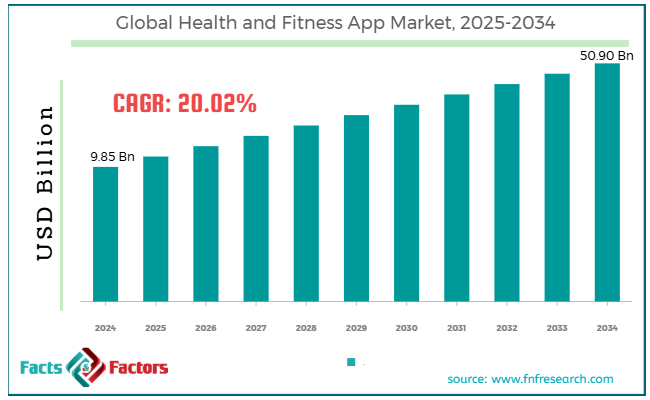Search Market Research Report
Health and Fitness App Market Size, Share Global Analysis Report, 2025 – 2034

Health and Fitness App Market Size, Share, Growth Analysis Report By Product Type (Exercise and Workout Apps, Nutrition and Diet Apps, Mental Health and Mindfulness Apps, Personalized Coaching Apps), By Platform (iOS, Android, Cross-Platform), By Target Audience (General Population, Athletes and Fitness Enthusiasts, Special Populations), And By Region - Global Industry Insights, Overview, Comprehensive Analysis, Trends, Statistical Research, Market Intelligence, Historical Data and Forecast 2025 – 2034
Industry Insights
[221+ Pages Report] According to Facts & Factors, the global health and fitness app market size was worth around USD 9.85 billion in 2024 and is predicted to grow to around USD 50.90 billion by 2034, with a compound annual growth rate (CAGR) of roughly 20.02% between 2025 and 2034.

 Market Overview
Market Overview
A health and fitness application is a smartphone app for users to track and enhance their fitness and health levels. These applications offer features like nutrition tracking, workout plans, progress tracking, and sleep monitoring. They also comprise exercise demonstrations, personalized fitness targets, and integration with wearables.
The global health and fitness app market is anticipated to grow substantially due to rising healthcare awareness, smartphone use, and integration of modernized technologies like ML, AI, and big data analytics. The growing awareness regarding the significance of a healthy lifestyle is propelling the demand for fitness and wellness applications.
At present, individuals are more concerned about their wellness and are opting for suitable ways to improve and monitor their health via fitness applications. The elevating use of smartphones is among the leading driving factors for the growth of these applications. Today, smartphones are integrated with improved sensors and strong processors so that apps can offer more developed features.
Furthermore, incorporating ML, AI, and big data analytics enables personalized fitness plans, more accurate health monitoring, and adaptive training programs, thus enhancing user experience and app usage rates.
Nevertheless, privacy and data security issues and significant subscription rates are the key hindering factors for global market growth. The market gathers sensitive data like personal information, health statistics, and activity patterns. There is a growing concern regarding security breaches and data privacy, which may refrain users from adopting these apps.
Moreover, since several applications offer free versions, many premium features come with costly subscription costs.
Hence, this pricing may be a hindering factor, mainly when the app comprises multiple subscriptions for diverse applications. Yet, the market will progress remarkably owing to opportunistic factors like corporate wellness programs and the incorporation of wellness and mental health.
Today, businesses and corporations actively adopt health-based initiatives to enhance employee productivity and wellness. Fitness applications that offer personalized wellness programs may benefit from long-term and large-scale contracts and a persistent stream of users.
Also, the focus on stress management and mental health is rising noticeably. By integrating meditation, mindfulness, and mental health wellness, fitness apps can appeal to a more extensive user base and offer well-being and holistic solutions.
 Key Insights:
Key Insights:
- As per the analysis shared by our research analyst, the global health and fitness app market is estimated to grow annually at a CAGR of around 20.02% over the forecast period (2025-2034)
- In terms of revenue, the global health and fitness app market size was valued at around USD 9.85 billion in 2024 and is projected to reach USD 50.90 billion by 2034.
- The health and fitness app market is projected to grow significantly owing to the growing health awareness among a larger population, increasing penetration of smartphones with fitness and wellness apps, and rising popularity of wearables.
- Based on app type, the exercise and workout apps segment is expected to lead the market, while the nutrition and diet apps segment is expected to register considerable growth.
- Based on the platform, the Android segment is the dominating segment among others, while the iOS segment is projected to witness sizeable revenue over the forecast period.
- Based on the target audience, the general population segment is expected to lead the market compared to the athletes and fitness enthusiasts segment.
- Based on region, North America is projected to dominate the global market during the estimated period, followed by Asia Pacific.
 Growth Drivers
Growth Drivers
- Technological improvements in ML and AI boost the health and fitness app market growth
Technological advancements, especially machine learning and artificial intelligence, have significantly improved the personalization and functionality of fitness and health applications. These technologies allow applications to offer personalized workout plans, predictive analytics, and performance tracking, thus increasing the efficiency and engagement of the fitness applications.
Artificial intelligence makes personalized workout suggestions depending on the user's fitness goals and data. This offers more effective and targeted fitness schedules.
Applications, such as Aaptive and Freeletics, have incorporated artificial intelligence to develop innovative fitness plans that can be set depending on the user's feedback and progress.
- Growing focus on preventive healthcare to fuel the market growth
Users are inclined towards proactive health management instead of reactive treatment. This is increasing the demand for health and fitness applications. These applications emphasize physical fitness, motivate preventive measures, and promote better choices for health.
Health and fitness apps are actively used as solutions for weight management, chronic disease prevention, and overall wellness. Applications that track long-term metrics like blood glucose, blood pressure, and cholesterol are gaining prominence.
Also, applications like Omada Health and Health Mate by Withings offer solutions for preventing chronic illness by constantly monitoring key indicators.
 Restraints
Restraints
- Engagement challenges and user retention negatively impact the progress of the health and fitness app market
While health and fitness applications witness growth in fresh consumers, keeping them engaged for extended periods is challenging. Several users uninstall fitness applications just after downloading them, primarily due to a lack of perceived efficiency, motivation, or interest in the application.
Low user perseverance is a constant problem in the application market. Users may soon become bored if they don’t see results or if the application fails to offer enough workout variations, social features, or gamification.
A prominent fitness application, Strava, launched many novel features in 2024 to boost user engagement. This included ‘Strava Challenges’ and many group functions. Nonetheless, although these updates were exciting, the app’s retention rate was constant. This denoted the existing struggle to keep consumers motivated for long periods.
 Opportunities
Opportunities
- Growing demand for holistic wellness apps and mental health positively affects the health and fitness app market growth
While physical fitness and wellness remain a key focus, there has been a rising demand for tools or apps that offer stress management, mental health, and overall well-being. Fitness applications that provide mental health resources like mindfulness exercises, guided meditation, and stress-relief programs can capture holistic well-being trends.
The wellness market is actively inclining towards a more holistic view of mental and physical health. Applications that offer tools to manage sleep, mental health, and overall well-being effectively are expected to hold a larger share of the global health and fitness app industry.
 Challenges
Challenges
- Market competition and saturation restrict the growth of the health and fitness app market
The health and fitness app market is intensely competitive, with plenty of applications available in diverse categories, comprising workout tracking, weight management, and mental well-being. The absolute volume of choices may overpower consumers and challenge a single application to shine, mainly for newcomers.
A most prominent fitness application, 'MyFitnessPal,' experienced fierce competition from newbies like Lifesum and Whisk, emphasizing more intuitive tracking and meal planning features. To maintain its brand name in the market and position, the app extended its offerings and included exclusive partnerships and premium training features with health brands.
 Report Scope
Report Scope
Report Attribute |
Details |
Market Size in 2024 |
USD 9.85 Billion |
Projected Market Size in 2034 |
USD 50.90 Billion |
CAGR Growth Rate |
20.02% CAGR |
Base Year |
2024 |
Forecast Years |
2025-2032 |
Key Market Players |
MyFitnessPal, Fitbit, Strava, Nike Training Club, Headspace, Calm, Peloton, Noom, MapMyRun, Runkeeper, Lifesum, Yazio, Aaptiv, Jefit, Zwift, and others. |
Key Segment |
By App Type, By Platform, By Target Audience, and Region |
Major Regions Covered |
North America, Europe, Asia Pacific, Latin America, and the Middle East &, Africa |
Purchase Options |
Request customized purchase options to meet your research needs. Explore purchase options |
 Segmentation Analysis
Segmentation Analysis
The global health and fitness app market is segmented based on app type, platform, target audience, and region.
Based on app type, the global health and fitness app industry is divided into exercise and workout apps, nutrition and diet apps, mental health and mindfulness apps, and personalized coaching apps. The exercise and workout apps segment held a dominating market share in the previous year and is expected to lead over the forecast period. These mobile apps mainly offer users workout plans, fitness tracking, guided exercises, and performance analysis. The rising prominence of fitness tracking, home workouts, and general growth in wellness-conscious behavior across the globe fuels the growth of this segment.
Based on the platform, the global health and fitness app industry is segmented as iOS, Android, and cross-platform. The Android segment registered a significant share of the market and will continue to lead in the future owing to its broad user base. Compared to the iOS platform, the number of Android smartphone users is rising globally. Hence, android holds a maximum consumer base, mainly in the developing regions. The growing number of Android devices, from medium-budget to premium mobiles, enables wellness apps to reach a larger population. The incorporation of Google Fit and several other Android features also aids app adoption.
Based on the target audience, the global market is segmented into general population, athletes and fitness enthusiasts, and special populations. The general population segment registered a notable share of the global market in 2024 and is projected to lead in the future. This broad audience comprises people of all age groups and fitness levels who are seeking convenient tools to enhance their overall health, stay fit, and manage stress. The demand for these apps has elevated in the past few years as more individuals welcome a healthy lifestyle, mainly during and after COVID-19. This has increased the significance of digital fitness tools via smartphones.
 Regional Analysis
Regional Analysis
- North America to witness significant growth over the forecast period
North America held a considerable share in the health and fitness app market in the previous year owing to increased smartphone penetration, a growing health-conscious population, and high technological improvements. On a global scale, North America holds the leading position in smartphone adoption rates. This facilitates the broader use of fitness and wellness applications.
Also, the region's rising emphasis on wellness and health is one of the top drivers. The United States has experienced a nearly 16% increase in the number of individuals adopting wellness apps over the past few years., with more Americans emphasizing fitness, mental health, and weight management goals.
Furthermore, North America is home to several prominent fitness and wellness application developers, including MyFitnessPal, FitBit, and Peloton, which have led to regional growth. North America is also an early adopter of improved technologies like AI-based fitness solutions and wearables.
Asia Pacific is projected to be the second leading region in the market due to rising smartphone adoption, growing health awareness, and affordable fitness solutions. The region has experienced speedy adoption of mobiles in the past decade, with over 60% of the population using smartphones and devices in 2024. This increased the accessibility of fitness and health apps to a broader population. Also, there is a growing emphasis on wellness and fitness in economies like Japan, China, and India, fueled by the increasing health concerns and urbanization.
In addition, several fitness applications in Asia Pacific offer fermium and affordable models, thus increasing their accessibility to a larger population comprising developing nations. This increased accessibility is driving the adoption in both rural and urban areas.
 Competitive Analysis
Competitive Analysis
The global health and fitness app market is led by players like:
- MyFitnessPal
- Fitbit
- Strava
- Nike Training Club
- Headspace
- Calm
- Peloton
- Noom
- MapMyRun
- Runkeeper
- Lifesum
- Yazio
- Aaptiv
- Jefit
- Zwift
 Key Market Trends
Key Market Trends
- Personalized AI-based fitness plans:
AI-based apps that offer personalized advice and fitness plans are gaining tremendous traction. These applications analyze user data to create tailored nutrition and workout plans. This trend fuels user retention and engagement, impelling the global market growth.
- Emphasis on mindfulness and mental health:
Mental health features like stress reduction, meditation, and mindfulness exercises are popular in fitness applications. Trending apps like Headspace and Calm are extending their offerings to comprise features beyond physical fitness, thus responding to the demand for all-inclusive health solutions.
The global health and fitness app market is segmented as follows:
 By App Type Segment Analysis
By App Type Segment Analysis
- Exercise and Workout Apps
- Nutrition and Diet Apps
- Mental Health and Mindfulness Apps
- Personalized Coaching Apps
 By Platform Segment Analysis
By Platform Segment Analysis
- iOS
- Android
- Cross-Platform
 By Target Audience Analysis
By Target Audience Analysis
- General Population
- Athletes and Fitness Enthusiasts
- Special Populations
 By Regional Segment Analysis
By Regional Segment Analysis
- North America
- The U.S.
- Canada
- Mexico
- Europe
- France
- The UK
- Spain
- Germany
- Italy
- Rest of Europe
- Asia Pacific
- China
- Japan
- India
- Australia
- Southeast Asia
- Rest of Asia Pacific
- The Middle East & Africa
- Saudi Arabia
- UAE
- Egypt
- Kuwait
- South Africa
- Rest of the Middle East & Africa
- Latin America
- Brazil
- Argentina
- Rest of Latin America
Industry Major Market Players
- MyFitnessPal
- Fitbit
- Strava
- Nike Training Club
- Headspace
- Calm
- Peloton
- Noom
- MapMyRun
- Runkeeper
- Lifesum
- Yazio
- Aaptiv
- Jefit
- Zwift
Frequently Asked Questions

Copyright © 2024 - 2025, All Rights Reserved, Facts and Factors


